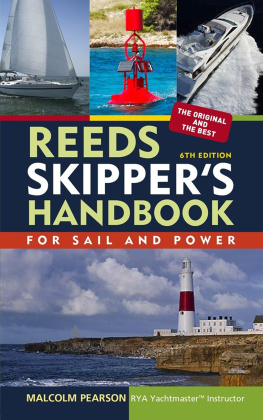
Dedicated to Jack my evening star.
May he never lose his way.
And Major safe in harbour now.
Published by Adlard Coles Nautical
an imprint of Bloomsbury Publishing Plc
50 Bedford Square, London, WC1B 3DP
www.adlardcoles.com
This electronic edition published in 2013 by Bloomsbury Publishing Plc
Copyright Malcolm Pearson, 1993, 1995, 2000, 2004, 2007
First edition published by Thomas Reed Publications 1993
Second edition 1995
Revised 1998
Third edition 2000
Reprinted 2002
Fourth edition published by Adlard Coles Nautical 2004
Fifth edition 2007
Sixth edition 2010
Print ISBN 978-1-4081-2477-2
ePub ISBN 978-1-4081-5629-2
ePDF ISBN 978-1-4081-0772-0
All rights reserved.
You may not copy, distribute, transmit, reproduce or otherwise make available this publication (or any part of it) in any form, or by any means (including without limitation electronic, digital, optical, mechanical, photocopying, printing, recording or otherwise), without the prior written permission of the publisher. Any person who does any unauthorised act in relation to this publication may be liable to criminal prosecution and civil claims for damages.
Malcolm Pearson has asserted his right under the Copyright, Designs and Patents Act, 1988 to be identified as the author of this work.
A CIP catalogue record for this book is available from the British Library.
Note: While all reasonable care has been taken in the preparation of this publication, the author and publisher accept no responsibility for any errors or omissions or consequences ensuing upon the use of the methods, information or products described in the book.
Original drawings by Sherrie Pearson;
Illustrations by Barbara McGavin and Dave Saunders
Visit www.bloomsbury.com to find out more about our authors and their books. You will find extracts, author interviews, author events and you can sign up for newsletters to be the first to hear about our latest releases and special offers.
First published in 1993, Reeds Skippers Handbook soon became a nautical best seller. It is now sold worldwide and appears in several foreign language editions. This 6th edition has been revised and updated to include useful extra information on tides, chart plotting, boat handling and knots plus a new section on sails and wind.
GPS and electronic chart plotters have significantly affected the way we navigate and made it possible for us to fix our position with greater accuracy than ever before. As a consequence, though, there is a danger that some skippers might become so reliant on their electronics that they forget how to navigate effectively without them. Of course, the electronic device that is guaranteed never to malfuntion has yet to be invented so it is unwise to neglect the traditional skills that will get you home safely if your GPS fails. Reeds Skippers Handbook is designed to explain the basics of traditional navigation and seamanship in simple terms, and solutions to most of the problems that are likely to occur during a coastal passage can be quickly found within its pages.
Malcolm Pearson
In recognition of the leading part played by the RYA in the promotion of safe practice for recreational boaters, it should be noted that many of the techniques explained in this book emanate from the RYA and are those routinely taught by RYA trained instructors to students enrolled on their navigation and seamanship courses.
The figures on are based upon or are reproduced from Admiralty Charts or publications with permission from The Controller of Her Majestys Stationery Office and the UK Hydrographic Office.
The Life Saving Signals on are based upon material issued by the MCA and are reproduced with their kind permission.
Thanks to Practical Boat Owner for permission to reproduce material previously published in that magazine.
Finally, my special thanks to my wife Sherrie without whose help and artistic ability this book would not have been published.
NOTE: Every effort has been made to find the copyright holders of any material used in this book that is not the authors own.
Latitude and longitude
The network of imaginary lines seen on a globe of the world is used to define position on its surface. The horizontal lines are parallels of latitude and the vertical lines that converge at the poles are meridians of longitude ().
Latitude is measured vertically along a meridian from 0 to 90 either north or south of the Equator ().
Longitude is measured horizontally round the equator from 0 to 180 either east or west of the Greenwich Meridian ().
Lines of latitude and longitude form complete circles around the globe. There are 360 in a circle and each degree can be divided into 60 minutes.
Using these co-ordinates, any place on Earth can be precisely defined as a position of latitude and longitude.
Traditionally, latitude is always given first followed by longitude and in coastal navigation, position is usually defined to the nearest minute, or if greater accuracy is required, tenths of a minute can also be quoted, ie:
Bishop Rock 49 52.3N 006 26.7W
Mercator projection
To portray the global Earth on a flat chart a projection called Mercator is generally used. As with a globe, charts are also overprinted with a lattice of latitude and longitude but on a Mercator chart, the meridians are drawn parallel to each other. Doing this distorts the landmasses in an east-west direction so to preserve the shape of the land, the north-south distance between successive parallels of latitude is progressively increased in proportion toward each pole.

Mercator charts and rhumb Lines
The real value of Mercators projection is that although the scale of the landmasses is distorted, direction is unaffected. This means that a straight line drawn between any two positions on a Mercator chart will cross every meridian at the same angle, so the navigator has only to measure that angle to obtain the true course to follow from one position to the other ().
A line that crosses all meridians at the same angle is called a rhumb line.

Fig 4
The rhumb line course between two points is not, however, the shortest distance between them, this is only given by a Great Circle route, but for coastal and offshore passages of less than five or six hundred miles in low or middle latitudes, the difference is negligible and can be safely disregarded.
A Great Circle is the largest circle that can be drawn on the surface of the Earth, and the shortest distance between any two points on the surface lies along the arc of a Great Circle that passes through them both.
A Gnomonic chart portrays meridians as straight lines that converge toward the nearest pole. Parallels, other than the Equator, appear as curves.
Gnomonic charts are commonly used to plan long ocean voyages because a Great Circle route can be drawn on a chart as a straight line between the departure point and the intended destination ().

Next page





















